
Sunstone: A Detailed Gemstone Information Guide
Are you intrigued by the sunstone’s dance of light and rumoured restorative powers? A stone of legend and vitality, sunstone has charmed societies for centuries with its sunset hues and rich history. Feldspars, which make up more than half of the Earth's crust and are composed of aluminum and silicates, include sunstone as one of their varieties. In this comprehensive guide, learn how sunstone has been used to symbolize freedom and vitality and why it continues to be a gem favoured for its potential to bring light to the shadows of the mind and invigoration to the spirit.
Key Takeaways
-
Sunstone is a feldspar crystal associated with light and energy originating from the earth’s crust or volcanic lava. It is known for its unique iridescence and trichroic qualities due to mineral inclusions such as hematite, pyrite, goethite, and copper.
-
The historical significance of sunstone spans cultures and time, used as a navigation tool by Vikings and considered sacred in various ancient civilizations, with properties that symbolize divinity and creativity across many mythologies.
-
Sunstone has diverse healing properties, predominantly associated with the sacral and solar plexus chakras. It is believed to bring joy, emotional balance, personal power, and creativity while repelling negativity and fostering confidence and independence.
-
Due to its softness, feldspar jewelry requires special care. It is important to avoid exposing feldspar jewelry to high heat or sudden changes in temperature. Additionally, feldspar is an affordable replacement stone if damage occurs.
Exploring the Radiance of Sunstone
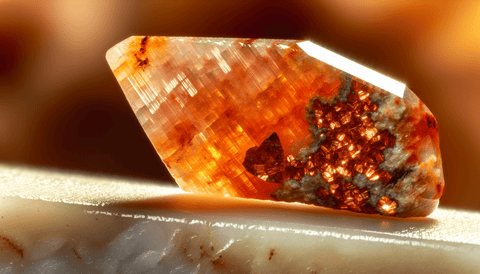
Sunstone is a captivating feldspar crystal with mesmerizing iridescence beneath its surface. Originating from the earth’s crust or volcanic lava remnants, this crystal embodies a complex and enchanting triclinic system. The sunstone meaning is often attributed to the play of light within it, an effect caused by the presence of other minerals, such as:
-
hematite
-
pyrite
-
goethite
-
sometimes even copper
Feldspar stones in jewelry require proper care and cleaning due to their unique characteristics, including their hardness and stability.
As light cascades over the sunstone, warm shades of red, orange, brown, and yellow spark to life, echoing the hues of a setting sun and capturing the essence of sunlight itself. The sunstone healing properties extend beyond its visual splendour, offering a connection to the ancient energies of our world and the celestial bodies above.
The Allure of Oregon Sunstone
The Oregon sunstone, characterized by its unique sparkle and rich colour palette, is a testament to nature's artistic brilliance. From the dusky reds and oranges to the serene greens and blues, the hues of the Oregon sunstone crystals form a spectrum as varied as the landscapes from which they emerge. These sunstone crystals, with their copper inclusions, create an optical phenomenon known as pleochroism, displaying colours that shift and shimmer with the stone's movement.
Oregon sunstones with strong, evenly distributed aventurescence are highly sought after. Their intense red or green hues mark them as jewels of exceptional worth. The sparkle of the Oregon sunstone crystal is unmatched, with the Schiller effect produced by its distinctive copper inclusions setting it apart from all other varieties and solidifying its coveted status in the world of gemstones.
The unique presence of copper endows the Oregon sunstone with a radiance that has captivated collectors and enthusiasts alike, making it a significant and treasured addition to any gemstone collection.
Aventurine Feldspar vs. Orthoclase Feldspar Sunstone
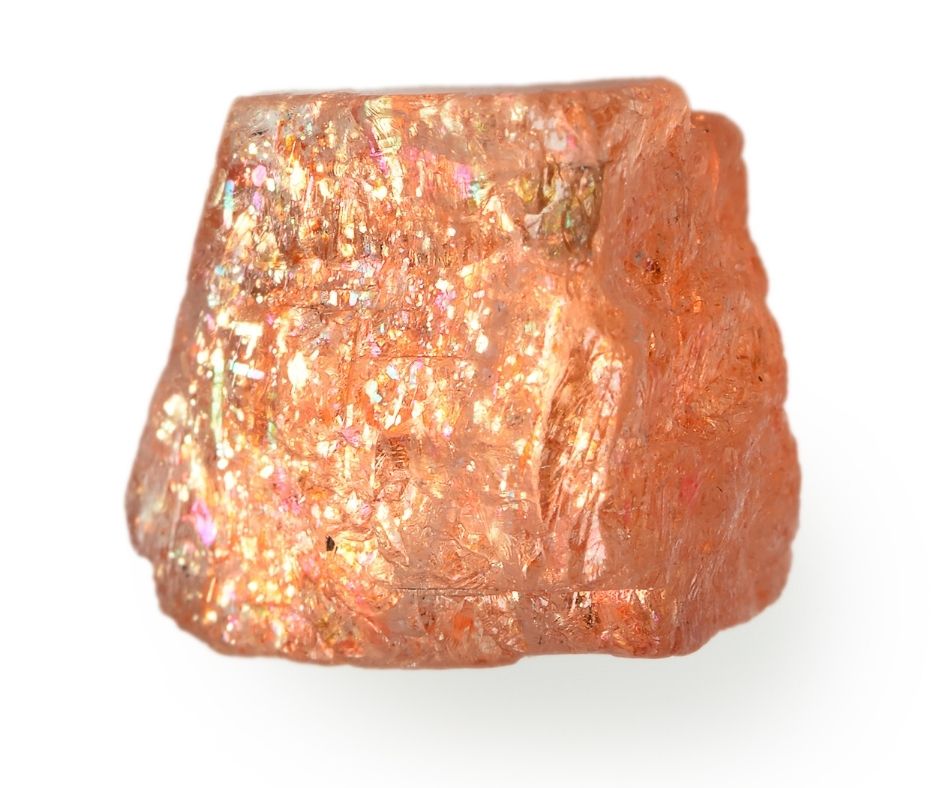
The comparison between aventurine feldspar and orthoclase sunstone reveals a fascinating tale of two stones, each boasting its unique allure. Orthoclase sunstone, a potassium-rich member of the feldspar minerals family, gleams with a transparent yellow hue, while aventurine feldspar, blending calcium and sodium, boasts a sunny glitter set against a red-brown body colour. The sparkly, metallic lustre known as aventurescence is particularly notable in aventurine feldspar, resulting from reflective inclusions that give the stone its characteristic schiller.
Each sunstone variety, whether belonging to the aventurine feldspar group or the orthoclase sunstone classification, displays distinct visual effects, a testament to the type and size of the mineral inclusions they harbour. These tiny inclusions, varying from stone to stone, are the artists behind the mesmerizing sunstone canvas, painting a portrait of light and colour that is as diverse as it is breathtaking.
Rainbow lattice sunstone, composed of orthoclase feldspar, stands out for its unique lattice pattern and iridescent play of colours. This rarity and visual appeal set it apart from other feldspar minerals like rainbow moonstone, making it highly desirable among gem and crystal collectors.
Moonstone vs Sunstone: What's the difference?
Moonstone and sunstone, both members of the feldspar family, possess unique characteristics that distinguish them. Moonstone typically appears in shades of white, gray, blue, peach, and pink, with a prized blue sheen due to its adularescence, which gives it a moonlit glow. It is associated with emotional balance, intuition, femininity, and fertility, making it a popular choice in jewelry and spiritual practices.
In contrast, sunstone ranges from pale yellow to deep red, orange, and brown, displaying a glittery aventurescence caused by tiny inclusions of copper or hematite. Known for boosting energy, vitality, joy, and optimism, sunstone is linked to the Solar Plexus Chakra and is also used in jewelry and crystal healing. While moonstone is connected to the moon and feminine energy, Sunstone is associated with the sun and personal power, each offering unique metaphysical benefits and visual appeal.
Sunstone's Historical Journey
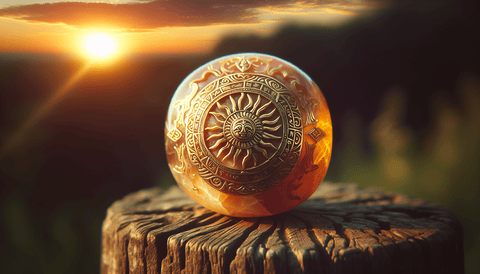
Join us on a historical journey with sunstone, a gem with a legacy that stretches across empires and eras, from the reign of Emperor Tiberius to being used as adornments by ancient civilizations. Sunstone's journey through history is as colourful as the gem itself, with its use as a decorative element in jewelry, talismans, and amulets by global cultures. The sunstone deposits have yielded treasures that connect us to the sun gods and the light they represent, with the name ‘sunstone' possibly originating from the Old Norse word ‘sunna.'
Islamic art and architecture have celebrated sunstone, with Prophet Muhammad speaking of its virtues and inclusion in mosque windows and decorative objects. The spiritual symbolism of sunstone extends to the Vairocana Buddha family, representing generosity and warmth. At the same time, myths and legends across cultures, from Vikings to Ancient Greeks, imbue the stone with mystical properties. It is a stone entwined with deities from Egyptian, Greek, Hindu, and Roman mythologies, such as:
-
Ra
-
Helios
-
Surya
-
Sól
This reinforces its status as a symbol of divine power and creativity.
Ancient Times and Sunstone Lore
In the annals of antiquity, sunstone, or heliolite as it was historically known, bore witness to the reverence of civilizations who looked to the heavens in awe. The etymology of its ancient name, derived from the Greek for sun and stone, reveals an intrinsic link to celestial wonder and the enduring human fascination with the cosmos.
The Ancient Greeks celebrated sunstone as a divine gift, a celestial token believed to descend during a solar eclipse and embody the radiance of their sun god, Ra.
The Ancient Egyptians adorned themselves with sunstone, attributing rejuvenating powers to its luminous presence and aligning it with their deities of light and life, Helios or Apollo. The use of sunstone in ancient rituals and art indicates the mystical properties and magical powers historically attributed to the mineral.
In Oregon, Native American legends speak of sunstone, which derives its sacred power and red shades from the blood of a fallen warrior, adding to the stone's mystique and symbolic value.
The Viking Sunstone and Navigation
Step into the legend of the Viking Sunstone, an iconic navigational tool that helped seafarers navigate through the North Atlantic's misty waters. Medieval texts and church inventories provide historical evidence of sunstones, supporting the legends that claim the Vikings used them as essential tools for exploration.
The Viking Sunstone, believed to be a calcite crystal, had the remarkable ability to polarize light and locate the sun's position. This skill was invaluable on overcast days or when the sun hid beyond the horizon. Dating back to the 12th century and possibly as early as the 8th century, the use of sunstones by Scandinavian sailors is a testament to their ingenuity and mastery of the unforgiving seas.
Computer simulations support the theory that Viking navigators could have used sunstones to travel accurately from Norway to Greenland, revealing their potential effectiveness as tools of ancient precision and ingenuity.
The Joyful Stone: Emotional and Spiritual Benefits

Known as the joyful stone, sunstone shines brightly in the realm of emotional and spiritual healing. Its radiant energy illuminates darkness and affirms the joy of life. Sunstone is a powerful crystal that helps release negative emotions and trauma, instilling worthiness and optimism while promoting emotional balance and self-empowerment. Sunstone can transform negative aspects into positive feelings, reduce sadness, and create a sense of peace and empathy.
Known for its protective properties, sunstone repels negative energies and draws in positive ones, cleansing the aura to maintain a positive vibe. Symbolically, sunstone is associated with good luck, abundance, and creativity, encouraging exploration and new beginnings and fostering a sense of prosperity that aligns with the joy and happiness it inspires.
Fostering Personal Power and Independence
The luminescence of sunstone goes beyond aesthetics. It acts as a catalyst for inner transformation, empowering individuals to:
-
Uncover their true selves
-
Find their rightful place in the world
-
Instill joy, optimism, and courage
-
Boost personal power
-
Enhance leadership skills
-
Encourage self-discipline
-
Bring luck
-
Shield the wearer from negative energies
-
Provide support for building self-confidence
-
Break free from self-sacrificing habits
Sunstone, with its sunstone metaphysical properties, is a positive stone that contributes to an autonomous spirit, and its sunstone properties further enhance its appeal.
By inspiring the nurturing of one's talents and abilities and encouraging original thinking, sunstone leads to greater autonomy and is particularly beneficial for those in creative professions. Anecdotes suggest that harnessing the positive energy of sunstone can lead to significant life changes and improvements in self-worth, confidence, and mood. Worn as jewelry, sunstone can serve as a manifestation stone, enhancing creativity and potentially aiding in achieving professional advancement.
Overcoming Fear and Stress

Sunstone's cleansing rays reach out to the emotional realm, providing solace and strength for those dealing with fear and stress. Sunstone provides emotional support by bolstering self-worth and confidence, keys to emotional stability. It has the following benefits:
-
Activating the Sacral Chakra, it promotes emotional well-being
-
Aiding in mental clarity and regularity, essential in navigating life's turbulent waters
-
Clearing negative thoughts and significantly brightening the mood especially beneficial in cases of seasonal affective disorder
The simple act of rubbing a Sunstone Worry Stone releases natural endorphins, promoting feelings of calm and inner peace that resonate with each deep breath.
Sunstone acts as an anti-depressant, assists in repelling negative energy, and protects against those who drain others' energy, ensuring the individual's life force remains bright and undiminished.
Placing sunstones in personal environments can help dissipate fears and encourage joy. This can foster a more positive outlook and the strength to say ‘no,' which is crucial for overcoming fear and reducing stomach tension.
Sunstone Crystal Healing Properties and Its Chakra Connections
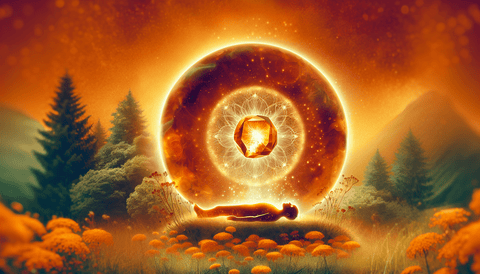
Sunstone serves as a channel for healing, with its properties deeply connected to the chakras - the energy centers within our bodies that govern our well-being. Predominantly linked with the sacral and solar plexus chakras, sunstone also resonates with the heart and third eye chakras, enhancing personal creativity and fostering healthier relationships.
Wearing sunstone jewelry, especially near areas of concern such as the heart or wrists, is thought to aid with various ailments, promote self-healing, and increase the flow of chi, an essential aspect of crystal healing and energetic alignment in personal spaces and feng shui.
Revitalizing the Sacral Chakra
The sacral chakra, a vital energy center associated with creativity and passion, finds a harmonious ally in sunstone. This stone's positive energy affects the sacral chakra by enhancing emotional expression, encouraging trust in relationships, and fostering joy and abundance. The nurturing energy of sunstone helps to unblock the sacral chakra, supporting effective communication, graceful movement, and the capacity to experience joy.
Charging sunstone and placing it over the sacral chakra can cleanse and activate this energy center, enhancing the flow of creative and passionate energies. The crystal's healing properties in relation to the sacral chakra are integral to one's emotional healing and sense of pleasure and fulfillment.
Empowering the Solar Plexus Chakra
Sunstone's bright, cheerful energy enhances the Solar Plexus Chakra, a center of personal power, confidence, and self-esteem. The Solar Plexus Chakra is where self-assurance and inner strength are cultivated, and Sunstone's uplifting energy promotes a warm, positive light, facilitating understanding and empowerment. It assists in:
-
Awakening and rejuvenating the Solar Plexus Chakra
-
Facilitating the release of pent-up emotions
-
Asserting personal desires
-
Contributing to personal growth and empowerment
By energizing this chakra, sunstone facilitates the release of pent-up emotions and the assertion of personal desires, contributing to personal growth and empowerment.
The benefits of sunstone for the Solar Plexus Chakra include boosting self-confidence, promoting personal power, encouraging positive thinking, and inspiring joy and abundance. Moreover, the stone's connection to this chakra aids in overcoming feelings of unworthiness.
It stimulates the motivation to take action toward one's goals, revealing hidden talents, especially in times of hesitation.
Using sunstone for the Solar Plexus Chakra during meditation can help reignite the flames of self-confidence, personal power, and joy.
The Lustrous Touch: Wearing Sunstone Jewelry
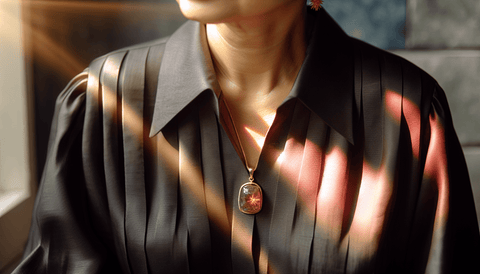
More than just an adornment, sunstone jewelry offers a range of benefits. Here are some reasons why you should consider wearing sunstone jewelry:
-
It is known for its restorative happiness and leadership attributes.
-
It links to the sun god's golden glow and the earth's nurturing embrace.
-
Wearing sunstone jewelry encourages self-confidence, creativity, and protection from negativity.
-
It helps in manifesting one's desires.
-
The direct contact with the skin when wearing sunstone as jewelry ensures a continuous positive energy infusion.
-
Sunstone has a good MOHS score, making it durable and suitable for everyday wear.
-
It seamlessly integrates its beneficial energies into daily life.
You can experience these benefits and embrace the stone's healing energy by wearing sunstone jewelry.
The sunstone jewelry comes in various forms, including earrings, pins, and necklaces, each piece a testament to the timeless appeal of this wonderful stone.
Sunstone bracelets, with their warm shades, are perfect for celebrating the summer season, adding a touch of warmth to seasonal outfits. To enhance self-healing powers and lush positivity, sunstone can be matched with crystals like Moonstone or Citrine, creating a symphony of energies that resonate with the wearer's intentions.
Integrating sunstone jewelry into one's lifestyle contributes to a journey toward achieving happiness, unleashing creativity, and embracing sustainable living.
Sunstone Jewelry as a Fashion Statement

The allure of sunstone jewelry surpasses its metaphysical properties, as its sparkling inclusions and light-catching ability make it a trending accessory. Some reasons why sunstone jewelry is popular include:
-
The pale peach hue and non-obtrusive elegance of sunstone
-
Its popularity for engagement rings, set against the backdrop of precious metals
-
The ability to embody an allure that is both subtle and powerful
Wearing sunstone rings offers multiple benefits:
-
It is considered a symbol of attracting luck, prosperity, and good fortune
-
It serves a functional purpose by maintaining the balance of the Solar Plexus Chakra when worn
-
It offers ongoing benefits alongside its fashion appeal
Sunstone jewelry is not only beautiful but also beneficial.
Selecting the Right Sunstone Piece
Selecting the ideal piece of sunstone jewelry should mirror one's intentions, whether to boost vitality or enhance creativity. Jewelry that allows for direct skin contact with the stone will enable the wearer to fully experience its energetic effects. Beaded sunstone jewelry offers an affordable option for those seeking to set personal intentions while customizing their pieces.
When selecting sunstone jewelry, it is important to look for:
-
Vibrant and clear stones, as colour and clarity, are indicative of the stone's quality
-
The cut of the sunstone influences how the stone captures light and reveals its characteristic glitter
-
Jewelry where the sunstone is securely set to prevent loss during wear
Sunstone jewelry should match the wearer's personal style, resonating on an emotional and aesthetic level and ensuring that the piece is worn and cherished. Some examples of sunstone jewelry include:
-
Sunstone rings
-
Sunstone necklaces
-
Sunstone bracelets
-
Sunstone earrings
High-end jewelry, such as engagement rings featuring sunstone cabochons, marries fashion with energetic benefits, making for a meaningful and stylish investment.
For those focused on energy work, selecting sunstone jewelry that allows for skin contact is paramount for experiencing the full benefits of this powerful crystal.
Caring for Your Sunstone
A routine of mindful cleansing and charging is necessary to maintain the sunstone's vibrant energy, thus preserving and enhancing its healing properties. Sunstone can be cleansed by methods such as sacred smoke, cleansing gems, or under running water, each technique renewing the stone's inherent vitality.
To charge sunstone, placing it in direct sunlight, using moonlight, or burying it in the Earth harnesses natural energies to rejuvenate the stone's healing capabilities. The importance of cleansing and charging sunstone lies in keeping its energy supportive and vibrant, particularly before programming it with intentions.
Due to sunstone's structural delicacy, it is essential to handle the stone carefully during these processes to prevent damage and ensure its long-lasting beauty.
Cleanse Sunstone to Renew Its Energy
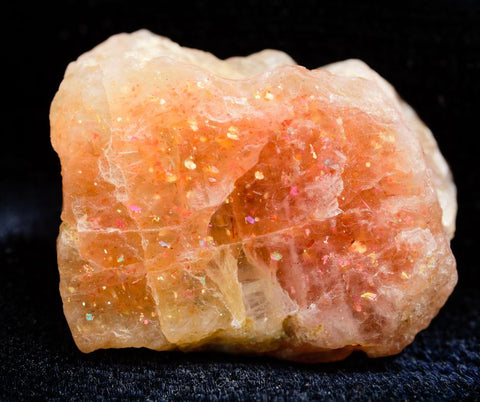
Cleansing marks the beginning of renewing the sunstone's energy, a process as simple as placing the stone under lukewarm running water to dispel the accumulated negative energy. After the water ritual, gently patting the stone dry with a soft cloth preserves its lustre and prepares it for further energetic work.
The use of sacred smoke, such as that from sage, sweetgrass, or palo santo, is another effective method for cleansing sunstone. These herbs' purifying properties restore sunstone's energies. Alternatively, placing sunstone near cleansing crystals like selenite or clear quartz can aid in purifying its energy, creating a synergistic effect that amplifies the cleansing process.
Charging Sunstone for Enhanced Healing
The ritual of charging sunstone infuses the stone with powerful energies, thereby enhancing its healing properties. Placing sunstone in sunlight for a short period can invigorate its healing properties; however, prolonged exposure should be avoided to prevent fading.
Similarly, charging sunstone under the full moon restores its energy and infuses it with a serene and balancing influence, best achieved by leaving it exposed for at least 4 hours. Burying sunstone in soil overnight aligns the stone with the grounding forces of nature, replenishing its vitality and strength.
Other valuable methods for charging sunstone include using sound vibrations from singing bowls or bells and placing the crystal on a Selenite plate for a minimum of 4 hours to cleanse and re-energize the stone for subsequent healing layouts.
The Many Faces of Sunstone: Varieties and Forms
The gemstone universe is enriched by the diversity of sunstones, presenting a myriad of forms and varieties, each with its unique charm and energy. Black sunstone, also known as black aventurine, hails from Southern India and is celebrated for its grounding energies and protective qualities.
Rainbow lattice sunstone, a rare and coveted type, mesmerizes with an intricate pattern of colours that dance across its surface, much like the iridescence of opals. Its internal inclusions and structural anomalies produce a captivating visual effect.
The Sunrise Sunstone, the largest known specimen of its kind, weighs a remarkable 1,383 carats. It was discovered in Oregon in the early 1990s, a testament to the grandeur and mystery sunstone brings to the gemstone universe. The Warner Valley in Oregon is renowned for its sunstone deposits found in ancient lava flows, providing materials that inspire carvers and upscale jewelry designers alike.
Sunstone's global presence reflects its universal appeal and the joy it brings to those who encounter it, from the United States to the far reaches of India, Russia, and Norway.
From Red to Golden: The Spectrum of Sunstone Hues
Part of sunstone's allure lies in its captivating colour spectrum, spanning fiery reds to tranquil golds. Each colour narrates a tale of the stone's origins and the elements that shaped it. The hue of sunstone is heavily influenced by the presence and amount of copper inclusions within the stone, with copper acting as the artist adding strokes of vibrant colour to the sunstone's canvas.
Distinct varieties, such as rainbow lattice sunstone, exhibit a remarkable range of colours, featuring exuberant reds, oranges, and yellows that come to life. Each hue is a testament to the stone's dynamic nature.
Not All Sunstones Are Created Equal
The Oregon sunstone variety is distinguished by an aventurescence effect, a sparkle produced by reflections from copper flakes aligned within its crystal structure, giving it a distinctive charm. Not all sunstones exhibit aventurescence; the effect depends on the presence and size of inclusions such as hematite or copper, which can vary among different types of sunstones, like the unique rainbow lattice sunstone.
Sunstone varieties from Oregon that may not present visible inclusions are still recognized as ‘Oregon sunstone' in the gem trade, showcasing the diversity within this type of sunstone.
Integrating Sunstone into Daily Life
Infusing daily life with sunstone's positive energy can transform ordinary spaces into sanctuaries of harmony and abundance. Integrating sunstone into home decor creates a welcoming atmosphere and promotes positivity and joy, fostering a hospitable environment, particularly where guests are entertained.
Placing sunstone in living areas can uplift the atmosphere, replacing negative energies with positive vibes and promoting a lively home environment. For those seeking an extra boost during daily routines, carrying a sunstone in their pockets allows for absorbing its vibrant energy, helping maintain high motivation levels. The vibrant energy of Sunstone encourages motivation, aiding in overcoming lethargy and benefiting those in demanding job environments.
Strategically placing sunstones where creativity and motivation are required, such as workspaces, can foster an abundance of innovative ideas. Having a sunstone present in personal spaces can be a powerful way to strengthen intentions, bringing life and joy into one's goals and daily actions.
Sunstone at Home for Harmony and Abundance
The crystal healing properties of sunstone can be harnessed to create an environment of harmony and abundance within the home. Known for its capacity to fill living spaces with positive energy, sunstone can aid in attracting prosperity and good fortune when strategically placed within a dwelling.
Its presence in living areas contributes to creating a joyful and harmonious atmosphere, making it a gemstone of choice for those looking to enhance the warmth and hospitality of their home.
Work Sunstone into Your Professional Environment
Sunstone's energizing qualities extend into the professional realm, where it supports developing and promoting leadership attributes. In the workplace, sunstone aids in cultivating charisma, openness, and courage, traits that are essential for effective leadership and personal responsibility. Incorporating sunstone into meditation practices at work, or simply having it within the work environment, clears the mind and enhances focus, which is vital for strategic planning and personal development.
Displaying sunstones in common areas, such as meeting rooms, can inspire a positive, optimistic, and collaborative atmosphere, contributing to a more pleasant work environment for all colleagues. Sunstone is considered a stone of good fortune; keeping it in the office is believed to attract success and abundance, which can be particularly beneficial for business endeavours.
Sunstone and Astrology: Zodiac Affinities
Sunstone's powers extend to a celestial dimension through astrological affinities, aligning its benefits with zodiac energies. The connection between sunstone and astrology is particularly strong with the sign of Leo, enhancing traits associated with leadership, confidence, and the sun god Ra's energy. For Leos, sunstone promotes:
-
A sense of freedom, fun, spontaneity, and adventure resonating with their love for good times and recognition
-
Self-expression and independence, aiding in overcoming ego issues and enhancing personal growth
-
Releasing energy drains from other people, ensuring their life force remains bright and undiminished
Yellow sunstone aligns with Leo, darker orange with Virgo, and red shades are particularly resonant with the sign of Libra, demonstrating the stone's versatility with different zodiac energies. For Libras, sunstone is considered a lucky charm, purported to bring fortune and tip the scales in favour of its wearers.
Sunstone Birthstone Magic
Sunstone holds a special place as a gemstone for those born under the sign of Libra, enhancing their natural qualities and serving as a birthstone that brings balance and fairness to their lives. For Libras, sunstone helps in restoring balance and encouraging their naturally just and fair approach to life while maintaining cordial relationships.
It is advised to consult with an expert astrologer when choosing sunstone jewelry to ensure positive alignment with one's astrological birth chart and tap into the birthstone magic that sunstone offers.
Aligning Sunstone with Zodiac Energies
Astrology enthusiasts can select sunstone jewelry that is aligned with their zodiac sign to gain personalized energetic benefits, making the stone an integral part of their spiritual and emotional journey. For Leos, sunstone helps illuminate and balance personality traits, fostering leadership qualities and contributing to fulfilling lives.
Aligning sunstone with one's zodiac energies can enhance personal growth, self-expression, and the confidence to shine brightly in all aspects of life.
Summary
In the tapestry of gemstones, sunstone stands out as a radiant thread that weaves together the sun's golden glow, the depth of historical significance, and the healing touch of Mother Nature. The journey through sunstone's radiant hues, historical lore, and metaphysical properties culminates in a gemstone that is as versatile in its applications as it is boundless in its beauty. By integrating sunstone into daily life, wearing it as jewelry, or aligning it with one's zodiac energies, we invite the sun's enduring power into our lives, embracing a stone that not only brings joy but also serves as a beacon of positivity, creativity, and abundance. With proper care, sunstone's lustre and energy can be a lifelong companion on the path to well-being and fulfillment.
Frequently Asked Questions
What does a sunstone crystal do?
A sunstone crystal is believed to inspire joy and enjoyment of life, cleanse auras and chakras, and is predominantly associated with the Base and Sacral Chakras.
Why is sunstone so expensive?
Sunstone is expensive due to its availability in transparent qualities. Transparent orange sunstones sell for more than translucent ones, and stones weighing one carat or more cost considerably more than small ones.
Who should wear sunstone?
Sunstone is beneficial for people born under the Moon Signs Pisces, Leo, and Libra. It is the birthstone of the zodiac sign Libra and is associated with the ruling planet of the Sun in astrology.
What makes Oregon Sunstone different from other sunstone varieties?
Oregon Sunstone stands out from other sunstone varieties due to its distinct sparkle and pleochroism, which are attributed to its unique copper inclusions. This makes it highly sought after by collectors.
How can Sunstone influence my emotional well-being?
Sunstone can positively influence your emotional well-being by releasing negative emotions, promoting emotional balance, and protecting you from negative energies. It ultimately contributes to a sense of joy and optimism.

